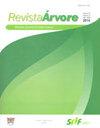INFLUENCE OF MOISTURE CONTENT ON PHYSICAL AND MECHANICAL PROPERTIES OF Vatairea SP WOOD
IF 0.8
4区 农林科学
Q4 FORESTRY
引用次数: 1
Abstract
ABSTRACT The recent interest in constructing high and robust wooden structures has stimulated the investigation of physical and mechanical properties as well as their correlation with other important parameters of the material of tropical species like the Vatairea sp., whose popular name is angelim-amargoso, used especially in roof structures with large spans. The Brazilian Standard for wood constructions recommends using linear models to correct or estimate the strength and/or stiffness of wood correlated with moisture content and also provides the classification of hardwoods according to their characteristic strength. However, because wood is a natural, heterogeneous, and anisotropic material, certain properties may not be affected by significant differences in moisture content. Therefore, in this study, the influence of moisture content on fifteen physical and mechanical properties of Vatairea sp. wood was investigated through its characterization. The tests were carried out on 12 specimens for each property and two groups: with the moisture content of 12% and at the fiber saturation point. The Anderson-Darling test was performed to verify the results’ normality and the analysis of variance (ANOVA) to analyze the influence of moisture content on these properties. In addition, the wood was classified according to the strength classes of the Brazilian Standard, and the strength and stiffness were estimated according to the linear models proposed by the same norm. The estimated results were compared with the experimental ones through the difference calculation and percentual error of the values. It was concluded that most properties were not affected by the moisture content, and the most significant errors obtained in the estimates were for properties that were significantly influenced by the moisture content.含水率对瓦泰莱木材物理机械性能的影响
近年来,人们对建造高大而坚固的木结构的兴趣刺激了对热带物种(如Vatairea sp.,其通俗名称为angelimi -amargoso)等材料的物理和机械性能及其与其他重要参数的相关性的研究,这些物种尤其用于大跨度的屋顶结构。巴西木结构标准建议使用线性模型来校正或估计与含水率相关的木材的强度和/或刚度,并根据其特征强度对硬木进行分类。然而,由于木材是一种天然的、不均匀的和各向异性的材料,某些特性可能不会受到含水量显著差异的影响。因此,在本研究中,通过表征,研究了水分含量对Vatairea sp.木材15种物理力学性能的影响。试验分为两组:含水率为12%和纤维饱和点两种,每种性能12个。采用Anderson-Darling检验验证结果的正态性,并采用方差分析(ANOVA)分析含水量对这些性能的影响。此外,根据巴西标准的强度等级对木材进行分类,并根据同一规范提出的线性模型对木材的强度和刚度进行估计。通过差值计算和值的百分比误差,将估计结果与实验结果进行了比较。得出的结论是,大多数性能不受水分含量的影响,估计中获得的最大误差是受水分含量显著影响的性能。
本文章由计算机程序翻译,如有差异,请以英文原文为准。
求助全文
约1分钟内获得全文
求助全文
来源期刊

Revista Arvore
FORESTRY-
CiteScore
1.00
自引率
0.00%
发文量
32
审稿时长
4-8 weeks
期刊介绍:
A Revista Árvore é um veículo de comunicação científica da Sociedade de Investigações Florestais – SIF. O jornal é de acesso gratuito, revisado por pares, que publica bimestralmente trabalhos científicos originais no campo da Ciência Florestal. As áreas temáticas para publicação são: Ambiência e Conservação da Natureza, Manejo Florestal, Silvicultura e Tecnologia da Madeira e Utilização de Produtos Florestais.
A política editorial visa manter alta conduta ética em relação à publicação e aos seus funcionários, rigor na qualidade dos artigos científicos, seleção de revisores qualificados, respeito profissional aos autores e processo de tomada de decisão imparcial. A Revista Árvore publica artigos apenas em inglês.
Artigos de revisão podem ser publicados se houver uma discussão relevante resumindo o estado da arte sobre o assunto. A revisão estrita da literatura não é aceita.
 求助内容:
求助内容: 应助结果提醒方式:
应助结果提醒方式:


